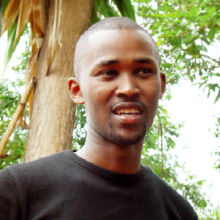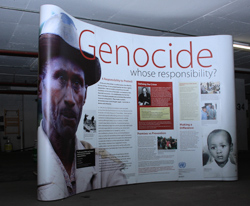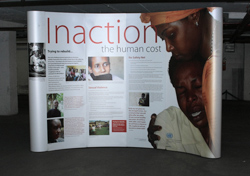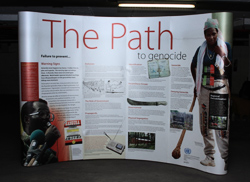
When you escape death, that's when you appreciate life. [...] Today, even when something saddens me, I look for a reason to be happy.I want to work hard and get somewhere in life. I know no one will have pity on me just because I'm an orphan.
Lessons from Rwanda
The "Lessons from Rwanda" exhibit is a production of Aegis Trust for genocide prevention (UK Registered Charity 1082856), in partnership with the United Nations.
The exhibit presents an account of the events taking place before, during and after the genocide. Its purpose is to raise awareness of the lessons to be learnt from those events, the work of the International Criminal Tribunal for Rwanda and other judicial mechanisms in ending impunity and the lasting impact of genocide on survivors.
The exhibit has been shown at schools and prisons throughout Rwanda, and in 2013 was hosted by a number of public high schools in New York City.
Available in English, French, Spanish and Kinyarwanda. Please contact us to enquire about hosting the exhibit.

Genocide - Whose responsibility?
At the end of World War II, world leaders, horrified by the mass killings of Jews perpetrated by the Nazi regime, adopted the 1948 Convention on the Prevention and Punishment of the Crime of Genocide, now known as the Genocide Convention. In it, world leaders for the first time criminalized genocide and committed themselves to prevent and punish it. They made a solemn declaration never to let it happen again – but it did, in Bosnia and in Rwanda.
Read More (PDF 1.8MB)
Rwanda - What would have prevented this?
Although the Rwandan genocide took many people by surprise, there had been enough warning signs that genocide was imminent. A history of discrimination, violence and massacres preceded and foretold the events of 1994.
Read More (PDF 3.4MB)
Inaction - The Human Cost
The costs of failing to prevent genocide are immense, whether measured in the number of lives lost or the suffering of survivors. According to the UN Children’s Fund (UNICEF), post-genocide Rwanda today has among the highest proportions of child-headed families in the world – some 42,000 households struggling to raise an estimated 101,000 children.
Read More (PDF 2.2MB)
The Path to Genocide
Genocide never happens by chance. It takes time to plan and organize. The warning signs are always there. In Rwanda, these were not acted upon effectively. World leaders ignored detailed warnings from UN peacekeepers on the ground that mass killings were imminent.
Read More (PDF 3MB)
